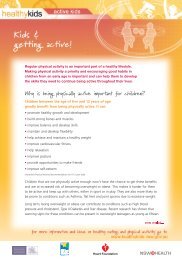The Physical Activity Handbook - Good For Kids
The Physical Activity Handbook - Good For Kids
The Physical Activity Handbook - Good For Kids
You also want an ePaper? Increase the reach of your titles
YUMPU automatically turns print PDFs into web optimized ePapers that Google loves.
P.24<br />
Figure 4: Generic levels of movement skill proficiency: observable characteristics 2<br />
Pre-control or beginner level – child’s:<br />
• movement isn’t repeated in succession; one attempt doesn’t look like another to perform<br />
the same movement<br />
• movement includes extraneous movements that are unnecessary for efficiently performing<br />
the skill<br />
• execution of the skill seems awkward and frequently doesn’t come close to performing the<br />
skills correctly<br />
• successful performances are characterised more by surprise than by expectancy<br />
• practices with a ball are uncontrolled, it seems to control the child<br />
Control or advanced beginner level – child’s:<br />
• movements appear less haphazard and seem to conform more to their intentions<br />
• movements appear more consistent and repetitions are somewhat alike<br />
• frequency in performing the skills correctly increases<br />
• attempt to combine one movement with another or perform the skill in relation to an<br />
unpredictable object or person is usually unsuccessful<br />
• concentration will be intense as the movement isn’t automatic<br />
Utilisation or intermediate level – child’s:<br />
• movements become more automatic and can be performed more successfully with concentration<br />
• performance of the skill, even when the context of the task is varied (slightly at first), is<br />
still successful<br />
• control of the skill is developed in predictable situations and is beginning to be skilful in<br />
unpredictable situations; execution of the skill in the same way is consistent<br />
• attempt to combine use of the skill with other skills is performed appropriately<br />
Proficiency or advanced level – child’s:<br />
• performance of the skill has become almost automatic and in similar contexts appear<br />
almost identical<br />
• focus on extraneous variables (an opponent, unpredictable object, flow of travel) doesn’t<br />
prevent them from performing the skill as intended<br />
• movement seems effortless as the child performs the skill with ease and seeming lack of attention<br />
• movement is performed successfully in a variety of planned and unplanned situations as the<br />
child appears to modify performance to meet the demands of the situation<br />
I Move We Move, <strong>The</strong> <strong>Physical</strong> Acitivity <strong>Handbook</strong> – Preschoolers, Edition 1 August 2009<br />
AREA HEALTH SERVICE<br />
P.24




